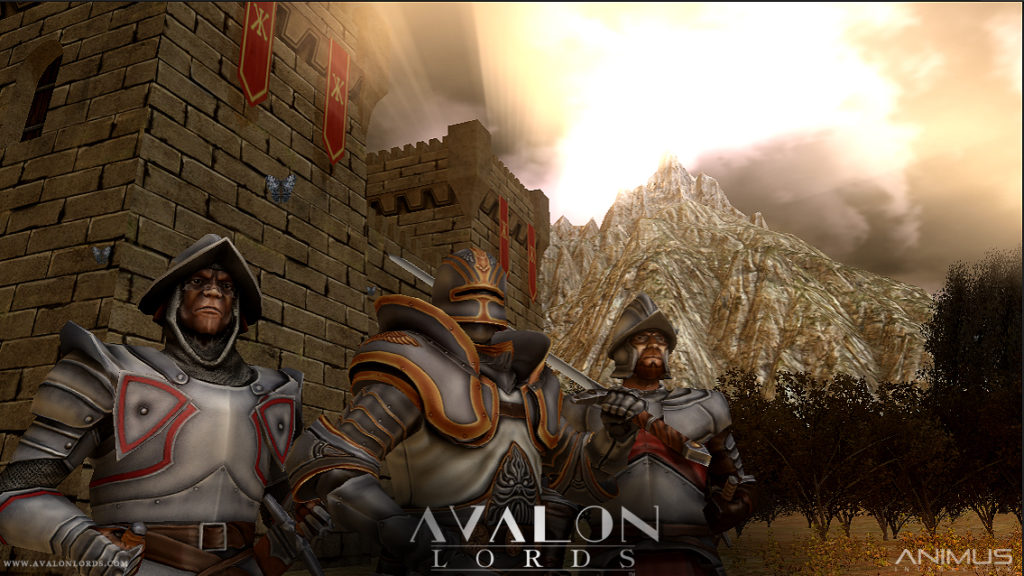
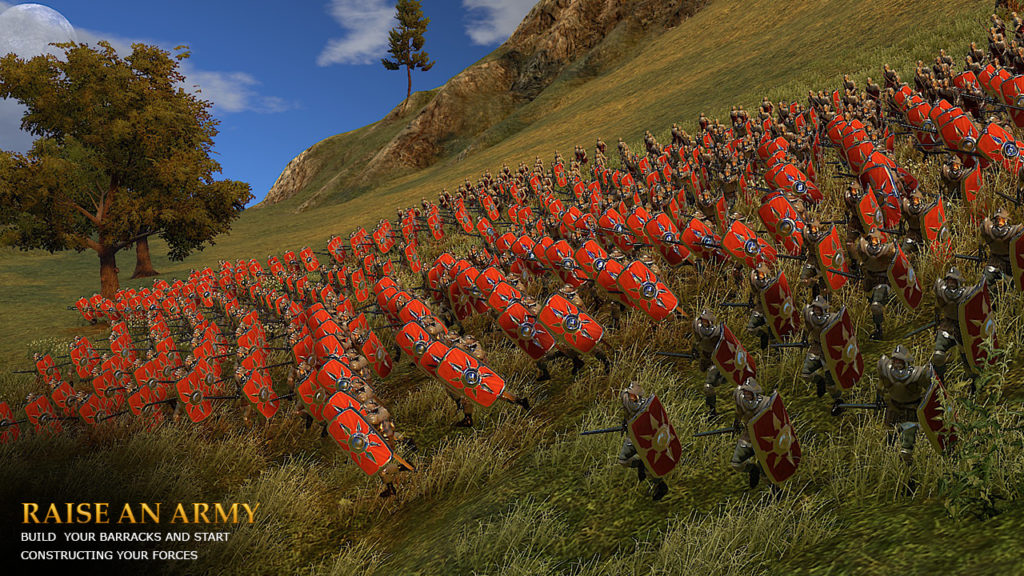
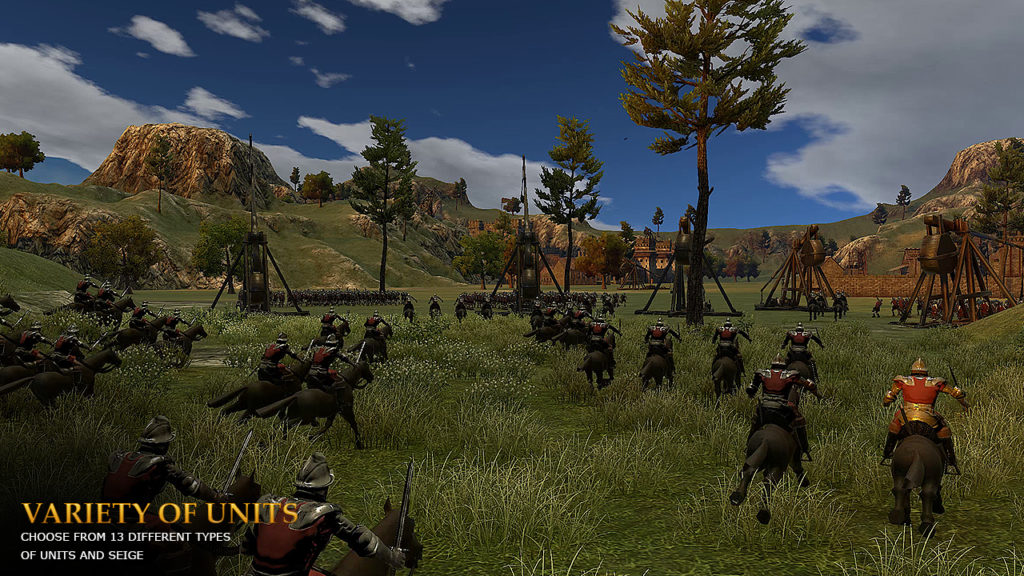
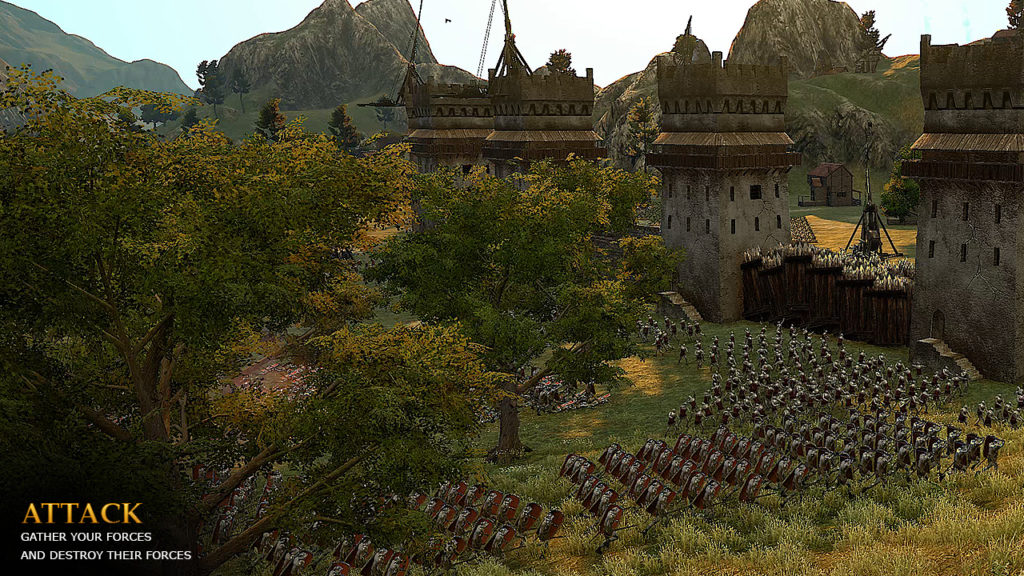
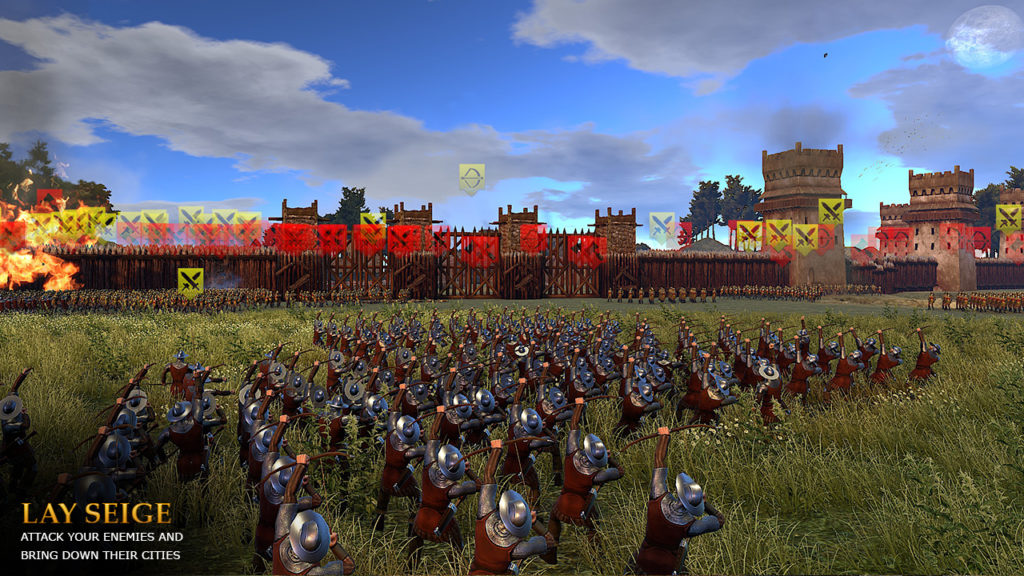
Avalon Lords
Role: Game Designer, Lead Writer
Team Size: 30
Time: February 2014 – July 2016
Engine: Unity 4
Game Summary
Avalon Lords was an MMORTS where players would choose one of three factions and wage war against one another for control of the land. Players start their game on a world map and see the state of the war before picking and choosing where to push for new territories or hold back the enemy. Each territory with its own benefits to provide each faction. Once in battle, players gather resources to build up their cities, defenses and massive armies.
Unfortunately, the game was downscaled from an MMO to an RTS and canceled shortly thereafter.
Responsibilities
- Game Designer
- Design and balance 3 asymmetric factions with their own specialties, and 12 unique units.
- Order of Dawn – This was the poster boy faction that used both magic and physical prowess to win the day. Their military doctrine specialized in the use of superior numbers and speed to win battles. While hordes of infantry are holding the line, players could use devastating cavalry charges to devastate and scatter enemy lines or use hit and run tactics to whittle down their enemies. As for their mages, they specialized in healing magic to support their troops with few offensive spells to try and control the flow of battle.
- Order of the Divine – Physically the weakest but the strongest magically, the Divine were designed with a high focus on utility and damage rather than durability. Their spells could control the battlefield and deal devastating damage when used correctly. For example, a unit specialized in ice magic could slow down or even hold targets in position while another rained fireballs over an area. To balance out their physical weakness the Divine had a few units of mages that specialized in close combat. While not as durable as the other two orders, they made up for it with the DPS they put out.
- Order of Darkness – Was the least magically gifted of the factions and least numerous. Physically they were the strongest. To make up for their lack of spells and numbers each soldier had to become an army in their own right and the use of technology helped balance the scales against wizards. As such, they had powerful warlord units that could single-handedly take on squads while inspiring their allies, Lancers that fought in tanks worth of armor with an equally thick tower shield and arrow carts that could cover battlefields in arrows.
- Design squad-based combat for massive battles with squads as large as 32 troops or as small as a single unit. Squads were comprised of several soldiers. Each soldier had their own stats that contributed to the squad as a whole. As squad members died the squad lost more of its combat effectiveness. Individual soldiers also matched up to play animations with other soldiers so players that wanted to get a good look at the battle in front of them could enjoy a good show.
- Expanded on the combat design to add more depth. This included formations, unit passive and active abilities, counters to cavalry like spear lines that had to be set up for incoming cavalry charges and much more.
- Design MMORTS territory control systems from open world to tile-based scopes where players fought for one of the three factions. Originally the scope of Avalon Lords was for us to operate on a fully open world with seamless loading between areas. But that proved to be far too large of our scope for our team, so we downsized to a tile-based system for players to wage war across.
- Open World System: Our original system went through several iterations, the first and one we wanted the most was to let players drop down a town center somewhere on the map and claim a large area around it as territory for themselves and their faction. The goal for players was to capture or destroy that town center in order to claim it as their own. We later adjusted to have players battle for designated control points. Whoever could capture and hold an area’s control point became its owner.
- Tile-Based System: Because an open world was too much for our team, we went to a tile-based map. Players would fight for control over map tiles over the course of a 24-hour period against NPCs, other players and deal with any events that might creep up. At the end of that 24-hour period, the map would update. Whoever had the most victories over a given territory became its owner. This system also opened up several new possibilities to us like certain tiles providing global resources to the owning factions and their players, special buffs or other advantages they could bring to battle against their enemies.
- Design and balance progression system. As players fought in battles, they gained experience points to earn new levels, each level earned players a skill point which allowed them to further specialize their playstyle beyond a faction choice. Each of the three factions could decide to upgrade their economy, units, or fortifications. While each faction shared many of these upgrades, they each also had unique upgrades only available to them. For example access to their faction-specific super unit.
- Design and balance each faction’s tech trees. These tech trees controlled what units, structures, and upgrades players had access to in each battle. For example, players need a barracks to produce infantry but building a barracks also unlocks access to the archery range. The tech tree also controlled access to upgrades players could purchase to buff their army’s capabilities on top of their own personal progression upgrades.
- Design quests and events. Because this was planned to be an MMO we needed quests and events to shake things up for players besides constant war with one another. These could be as simple as spend X number of resources or as complicated as capture a particular site to gain your own or even a faction wide buff.
- Design an end game. This was any of a certain set of conditions a faction had to achieve in order to win the current campaign they were on. Players could capture or destroy the other two faction’s capitol cities, secure Avalon at the center of the map for a duration or complete a number of event quests in order to become the champions of that campaign. At the end of a campaign, players were rewarded with titles and cosmetics unique to that campaign, their faction, and their method of victory which was meant to drive competition not just between the factions but the players within them. After a campaign was finished, the map was reset and players have to start again from scratch while carrying any earned cosmetics, titles and the like into the next campaign.
- Work with producers, programmers, and artists to oversee and assist with the implementation of new features and systems.
- Write extensive and detailed documentation on various systems and mechanics. We had a very hefty GDD by the end of the project.
- Break down systems and mechanics into small tasks to create tickets for developers.
- Provide regular feedback to the development team based on playtesting, to balance the game and fine-tune mechanics or systems.
- Create a work environment that fosters development, creativity, and teamwork. We achieved this with regular team meetings where everyone was encouraged to chime in on the project’s progress and what if anything about the game’s design needed adjusting.
- Design and balance 3 asymmetric factions with their own specialties, and 12 unique units.
- Lead Writer
- Write the world’s lore. This began when I was initially designing the three factions as they had no story to them, and I found it difficult to figure out what made each faction tick without one. So, I sat down and started writing up brief descriptions of each faction before proceeding to a timeline of events that lead to the world’s current state. From this timeline, I was able to greatly expand upon the world’s lore and write plenty of short stories that helped with the game’s marketing and informed the design of units, architecture, and future events.
- Write unique lore to each of the three factions that explained how they came together under Avalon’s banner before falling apart into warring factions. Each of these factions had their own major characters representing its different aspects. Like the strength of the Order of Darkness or the twisted magics and bitter feuds of the Divine.
- Write descriptions for units, structures, and upgrades. These had to be short, concise, and punchy lines that fit in tiny windows alongside any relevant statistics. These actually took longer to write than the short stories themselves because there was so much time spent polishing them and reducing their size.
- Write scripts for cutscenes, trailers, and unit lines.
- Worked with our writing team of an editor and one additional writer to create the vast amounts of lore needed by an MMO. This involved brainstorming sessions, picking each other’s writing apart and making any and all changes necessary to ensure we had polished lore players could dig into.
- Collaborate with artists and programmers to ensure the world’s lore was accurately conveyed in-game. A lot of time was spent gathering mountains of reference material here for artists and it was worth it with the amazing work they came out with.
Skills Gained or Improved
- Design for a large-scale project. This was my first project on such a large scale. Prior to this, I had no idea what scope was or anything about managing precious resources like time and money. Which really showed when I was more than happy to put 40+ hours of work without pay into the project. Can’t really afford to pull stunts like that anymore.
- Design Documentation and Methodology. This was my first look at proper documentation like GDD’s, how they’re laid out and the like. I also learned the importance of charts for communication and how invaluable quality spreadsheets are for balancing such a huge and complicated project.
- Interdisciplinary Communication. Prior solo works involved talking to no one other than myself, so it took some serious practice to learn the language of programmers, artists, and producers in order to effectively communicate with them and minimize confusion.
- Game Balancing. Spreadsheets are love. Spreadsheets are life.
- Story outlining, pacing, writing. You get out of a high school AP writing class and think you know everything about writing. Turns out there’s a lot more about how to properly plan out your stories, the borderline inescapability of the hero’s journey, and how to make sure all the pieces fit together cohesively. But it was a great deal of fun and this actually inspired me to start on my own novel while expanding my game design skills.
- Proper use of project management software, Jira in particular. Even with working exclusively with our small writing team of 3, project management software proved to be a necessity. It let me see who was doing what, when they started, and when it was expected by along with any specifications. And after writing far too long and detailed tickets, I learned the importance of splitting up tasks into multiple, concise, actionable tickets.
Challenges Overcome
- Working with a team for the very first time. There were some growing pains to be sure, especially when we absorbed a smaller team into ours that had a drastically different vision of what an RTS even was. We eventually got them to come around and they proved a great asset.
- Designing an MMORTS for my first big project. To say I was out of my depth during my first week would be a colossal understatement but that put me in a “sink or swim” state of mind. This pushed me to study even harder anything and everything I could about game design theory and start to dive deeper into code. Specifically, C# for Unity.
- Vast changes in project scope. As mentioned above our project shifted in scope from an open world MMORTS map to tile-based and ultimately down to a traditional RTS. It was hard to see so much time and effort go down the drain each time the scope changed but it taught me valuable lessons about learning to let things go and pushing onto the next challenges that needed tackling.